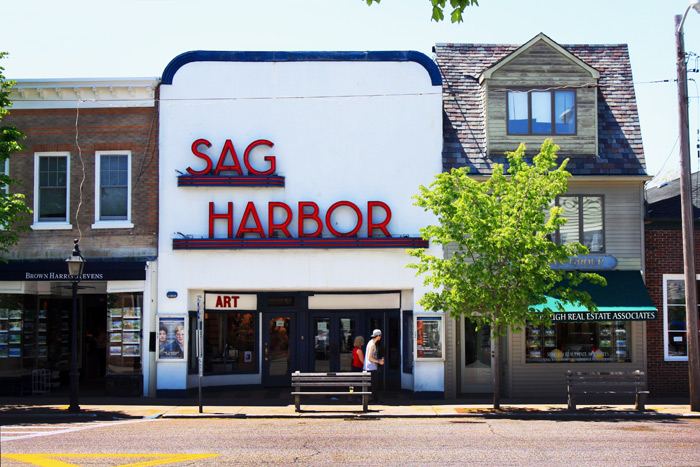Sag Harbor Cinema: A History

As is well known by most every resident of the East End, the iconic façade of the Sag Harbor Cinema, along with several other building on Main Street in the village, was destroyed when a fire swept through the buildings in the early morning of December 16. Less well known to some of our readers might be the long history of the place which would become the cultural center, smack in the middle, of the village’s business district. From its beginnings as a vaudeville stage and burlesque theater, to its championing of independent and art house film, we’ve put together a short history of the 101 year-old space at 90 Main Street in Sag Harbor.
The first theater to occupy the space, George’s Theater, built by George Kiernan, was opened in October, 1915. Town historian Dorothy Zaykowski reports that soon after opening a notice went out to “all law-abiding people” to “decline from patronizing the place” because George’s Theater had defied Town Ordinance number 15 and was open on Sundays.
In 1919 the theater was purchased by Marshall Seaton and reopened as the Elite Theater the same year. Its first full-length feature film was His Majesty, the American.
In 1927, Mike Glynne, who owned other theaters throughout the East End, purchased the Elite Theater for an amount rumored to be between $35,000 and $45,000 and renamed it Glynne’s Sag Harbor Theater. On October 13, 1929 the theater presented Kitty, believed to be the first talkie shown on the East End of Long Island. In September 1930, the theater was closed for six weeks while a new RCA Sound system was installed.
By 1936 the theater had undergone a complete makeover, designed by famed theater architect John Eberson of New York at the cost of $25,000. The main auditorium was demolished and a new, fireproof steel and concrete building was erected. The new auditorium, complete with 600 seats, was essentially what one would see today. A new lobby and box office were also built. Interior design was completed by Kenny Studios and Rambusch Decorating Company of New York. Is what at this time the concave arc façade was built and the 18-foot long, Art Deco red and blue neon Sag Harbor sign was added. The new theater opened June 3, 1936 with the Shirley Temple classic Captain January.
In May, 1978 Independent and foreign film aficionado Gerald Mallow purchased the theater and renamed it Sag Harbor Cinema. Though he did remove some seats, bringing the new total to 480, the rest of the theater remained mostly unchanged. The summer of that year, the cinema screened a French film, Madame Rosa. To Mallow’s surprise 275 people came for the show, thus beginning a long tradition of the cinema’s foreign film screenings.
In May, 2004, the iconic neon Sag Harbor sign, which had adorned the building since 1936, weather-beaten, rusted and in need of serious repair, was set to be taken down and discarded. Sag Harbor residents Brenda Siemer and Joe Pintauro, however, spearheaded an effort to save the sign. After mounting a successful fundraising campaign, a replica of the sign was created and reinstalled in October 2005. In 2008 Mallow listed the theater for lease or purchase for $12 million, and again in 2014 for $14 million.
While the theater’s façade was ultimately destroyed by fire on December 16, the Sag Harbor sign was spared, plucked from the rubble and is now in storage. The theater itself was also spared, save for water and smoke damage. Sag Harbor now awaits the theater’s next iteration, and a new, highly anticipated page in the history of the village.



